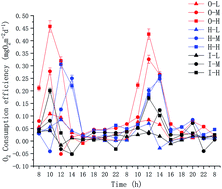Plant rhizosphere, soil microenvironment, and functional genes in the nitrogen removal process of bioretention†
Abstract
The coupling effect of plant, soil, and microbes in bioretention provides conditions conductive for nitrogen (N) removal via nitrification, accretion, denitrification, and dissimilatory nitrate reduction to ammonium (DNRA). To assess this process, the effects of plant rhizosphere, isotope labelled inorganic N distribution, soil microenvironment variation, and functional genes' abundance at different pollutant loads in simulated bioretention were evaluated. The results show that both nitrification and denitrification rates decreased with soil depths, and the maximum overall nitrification efficiency was about 3.4–4.4 times higher than that of denitrification. The overall nitrification rates decreased but the overall denitrification rates increased with pollutant loads, showing the limitation of bioretention for N removal at high loads within limited retention time. The radial oxygen loss (ROL) from the roots increased with the pollutant load. DO was higher while pH was lower in the rhizosphere soil compared with those in the soil of the same depth; thus, the nitrification rates was relative higher while the denitrification rates were lower in the rhizosphere soil. The sequence of nitrification rates was O > I > H at all soil depths, which is consistent with the DO and pH profiles of different plants at different loads. The abundance of 16S rRNA genes, nitrifying genes (amoA, nxrB), and denitrifying genes (narG, nirK, qnorB and nosZ) in the soil of plant group were higher than those of the control group without plant, suggesting that plants help increasing soil microbial abundance. The abundance of 16S rRNA genes, nitrifying genes, and denitrifying genes decreased with soil depth. More copies of denitrifying genes in the topsoil, which was thought as aerobic conditions, suggests that denitrification may occur in anoxic microenvironment of the topsoil or during stormwater retention period. Moreover, the root exudates and other organic matter accumulated in the topsoil may provide carbon sources for local denitrification in bioretention.

- This article is part of the themed collection: Geochemistry


 Please wait while we load your content...
Please wait while we load your content...